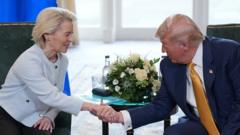The United States and the European Union have successfully finalized a comprehensive trade agreement, concluding a prolonged impasse between two major economic entities. Following intense discussions in Scotland, US President Donald Trump and European Commission President Ursula Von der Leyen announced the implementation of a 15% tariff on all European goods entering the U.S., a significant reduction from the previously threatened 30% tariff.
Trump emphasized that the deal would open doors for European markets, where certain American products will benefit from zero tariffs. “We have reached a deal. It’s a good deal for everybody,” he stated, underscoring the cooperative spirit of the negotiations.
Both leaders lauded the significance of this agreement, which is anticipated to inspire stability in trade relations, as the EU and the US collectively represent nearly one-third of the global trading landscape. Von der Leyen characterized the deal as a substantial achievement following rigorous negotiations, which would help remake the economic dynamics between the two blocs.
Additionally, the agreement entails that the EU will invest a monumental $600 billion in the U.S. economy, procure military equipment worth hundreds of billions, and allocate approximately $750 billion toward energy investments. This aims to lessen European dependency on Russian energy resources, a pertinent issue amid ongoing geopolitical tensions.
Despite this progress, Trump stated that tariffs on steel and aluminum, introduced globally, would remain intact. Both parties view the agreement as a mutually beneficial arrangement. For the EU, the 15% tariff is a better outcome than the UK's 10% tariff, while the U.S. can expect around $90 billion in potential tariff revenue based on past trade statistics, alongside newfound substantial investments.
Trade figures reveal that approximately $975.9 billion worth of goods were exchanged between the EU and the US last year, with a notable trade deficit for the United States. Concerns arose over potential retaliations from the EU, which threatened tariffs on American imports, including vehicles and agricultural products.
Looking forward, Prime Minister Keir Starmer of the UK is scheduled to meet with Trump soon, while the U.S. president will make appearances at his family’s golf establishments in Scotland, indicating a strategic engagement in fostering international relations.
Trump emphasized that the deal would open doors for European markets, where certain American products will benefit from zero tariffs. “We have reached a deal. It’s a good deal for everybody,” he stated, underscoring the cooperative spirit of the negotiations.
Both leaders lauded the significance of this agreement, which is anticipated to inspire stability in trade relations, as the EU and the US collectively represent nearly one-third of the global trading landscape. Von der Leyen characterized the deal as a substantial achievement following rigorous negotiations, which would help remake the economic dynamics between the two blocs.
Additionally, the agreement entails that the EU will invest a monumental $600 billion in the U.S. economy, procure military equipment worth hundreds of billions, and allocate approximately $750 billion toward energy investments. This aims to lessen European dependency on Russian energy resources, a pertinent issue amid ongoing geopolitical tensions.
Despite this progress, Trump stated that tariffs on steel and aluminum, introduced globally, would remain intact. Both parties view the agreement as a mutually beneficial arrangement. For the EU, the 15% tariff is a better outcome than the UK's 10% tariff, while the U.S. can expect around $90 billion in potential tariff revenue based on past trade statistics, alongside newfound substantial investments.
Trade figures reveal that approximately $975.9 billion worth of goods were exchanged between the EU and the US last year, with a notable trade deficit for the United States. Concerns arose over potential retaliations from the EU, which threatened tariffs on American imports, including vehicles and agricultural products.
Looking forward, Prime Minister Keir Starmer of the UK is scheduled to meet with Trump soon, while the U.S. president will make appearances at his family’s golf establishments in Scotland, indicating a strategic engagement in fostering international relations.















